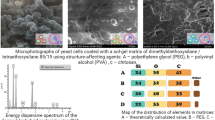Abstract
The sol–gel process is an effective method to encapsulate living cells into a three-dimensional silica network under mild conditions. In this work, the structure and properties of biohybrids obtained by immobilizing methylotrophic yeast in a one-step sol–gel synthesis process (pH 7.6) from tetraethoxysilane (TEOS) and dimethyldiethoxysilane (DDS) in the presence of polyethylene glycol (PEG) were investigated. When using DDS organic modifier, gel shells forming around the cells are thinner than those when using MTES. Biohybrid material based on methylotrophic yeast immobilized in organically modified silica (ORMOSIL) gels with TEOS to DDS ratio of 15:85% (vol.), shows the greatest respiration activity during methanol biodegradation. The structure of this material is formed by the smallest number of Si-O-Si-bonds and, therefore, the largest number of free silanol groups. We believe that this creates a comfortable environment for encapsulated microorganisms. This study showed that there was a delicate balance between hydrophilic and hydrophobic components in ORMOSIL matrices for immobilized microorganisms.

Highlights
-
The structure of ORMOSIL material obtained in a one-step sol–gel synthesis process (pH 7.6) from TEOS and DDS (15:85(vol)) in the presence of PEG is formed by the smallest number of Si-O-Si-bonds and, therefore, the largest number of free silanol groups.
-
Immobilization of yeast cells by one-step sol–gel synthesis (pH 7.6) from TEOS, alkylalkoxysilane (MTES or DDS) as hydrophobic organic modifier and PEG as hydrophilic organic modifier leads to the spontaneous formation of ORMOSIL shells around living cells, regardless of the type of alkylalkoxysilane.
-
There was a delicate balance between hydrophilic and hydrophobic components in ORMOSIL matrices for immobilized microorganisms and for design of “living” hybrid materials.
-
“Living” hybrid materials based on encapsulated methylotrophic yeast show high respiration activity during methanol biodegradation and present promising functional materials in the design of biocatalysts and biosensitive surfaces of biosensors.



Similar content being viewed by others
References
Gupta R, Kumar A (2008) Molecular imprinting in sol-gel matrix. Biotechnol Adv 26:533–547. https://doi.org/10.1016/j.biotechadv.2008.07.002
Tripathi VS, Kandimalla VB, Ju H (2006) Preparation of ormosil and its applications in the immobilizing biomolecules. Sens Actuators B Chem 114:1071–1082. https://doi.org/10.1016/J.SNB.2005.07.037
Schmidt H, Scholze H, Kaiser A (1984) Principles of hydrolysis and condensation reaction of alkoxysilanes. J Non Cryst Solids 63:1–11. https://doi.org/10.1016/0022-3093(84)90381-8
Sakka S, Tanaka Y, Kokubo T (1986) Hydrolysis and polycondensation of dimethyldiethoxysilane and methyltriethoxysilane as materials for the sol-gel process. J Non Cryst Solids 82:24–30
Mah SK, Chung IJ (1995) Effects of dimethyldiethoxysilane addition on tetraethylorthosilicate sol-gel process. J Non Cryst Solids 183:252–259. https://doi.org/10.1016/0022-3093(94)00631-8
Kruk M, Asefa T, Coombs N et al. (2002) Synthesis and characterization of ordered mesoporous silicas with high loadings of methyl groups. J Mater Chem 12:3452–3457. https://doi.org/10.1039/b205217b
Rabbani MM, D-GN WOh (2011) Synthesis and characterization of methyltriethoxysilyl- mediated mesoporous silicalites. Trans Electr Electron Mater 12:119–122. https://doi.org/10.4313/TEEM.2011.12.3.119
Putz AM, Wang K, Len A et al. (2017) Mesoporous silica obtained with methyltriethoxysilane as co-precursor in alkaline medium. Appl Surf Sci 424:275–281. https://doi.org/10.1016/j.apsusc.2017.04.121
Zheng C, Lin A, Zhen X et al. (2007) Structural and textural evolution of dimethyl-modified silica xerogels. MatLett 61:2927–2930
Wang F, Liu J, Luo Z et al. (2007) Effects of dimethyldiethoxysilane addition on the sol–gel process of tetraethylorthosilicate. J Non Cryst Solids 353:321–326. https://doi.org/10.1016/J.JNONCRYSOL.2006.05.033
Borówka A (2018) Effects of twin methyl groups insertion on the structure of templated mesoporous silica materials. Ceram Int. https://doi.org/10.1016/J.CERAMINT.2018.11.152
Vergnes A, Nobili M, Delord P et al. (2003) Auto-organisation in silica-based organic-inorganic gels obtained by sol-gel process. J Sol-Gel Sci Technol 26:621–624. https://doi.org/10.1023/A:1020788424622
Pandey S, Mishra SB (2011) Sol-gel derived organic-inorganic hybrid materials: Synthesis, characterizations and applications J Sol-Gel Sci Technol 59:73–94. https://doi.org/10.1007/s10971-011-2465-0
Ciriminna R, Fidalgo A, Pandarus V et al. (2013) The sol-gel route to advanced silica-based materials and recent applications. Chem Rev 113:6592–6620. https://doi.org/10.1021/cr300399c
Livage J, Coradin T (2001) Encapsulation of biomolecules in silica gels. J Phys Condens Matter 13:R673–R691
Alvarez GS, Pieckenstain FL, Desimone MF et al. (2010) Evaluation of sol-gel silica matrices as inoculant carriers for Mesorhizobium spp. cells. In: Mendez-Vilas A (ed) Current Reseach, Technology and Education Topics in Applied Microbiology and Microbioal Biotechnology. FORMATEX, pp. 160–166
Homburg SV, Venkanna D, Kraushaar K et al. (2019) Entrapment and growth of chlamydomonas reinhardtii in biocompatible silica hydrogels. Colloids Surf B Biointerfaces 173:233–241. https://doi.org/10.1016/j.colsurfb.2018.09.075
Meunier CF, Dandoy P, Su B-L (2010) Encapsulation of cells within silica matrixes: Towards a new advance in the conception of living hybrid materials. J Colloid Interface Sci 342:211–224. https://doi.org/10.1016/j.jcis.2009.10.050
Dickson DJ, Ely RL (2013) Silica sol-gel encapsulation of cyanobacteria: Lessons for academic and applied research. Appl Microbiol Biotechnol 97:1809–1819. https://doi.org/10.1007/s00253-012-4686-8
Jia J, Tang M, Chen X et al. (2003) Co-immobilized microbial biosensor for BOD estimation based on sol-gel derived composite material. Biosens Bioelectron 18:1023–9. https://doi.org/10.1016/S0956-5663(02)00225-7
Depagne C, Roux C, Coradin T (2011) How to design cell-based biosensors using the sol–gel process. Anal Bioanal Chem 400:965–976. https://doi.org/10.1007/s00216-010-4351-y
Aukema KG, Kasinkas L, Aksan A, Wackett LP (2014) Use of silica-encapsulated Pseudomonas sp. strain NCIB 9816-4 in biodegradation of novel hydrocarbon ring structures found in hydraulic fracturing waters. Appl Environ Microbiol 80:4968–4976. https://doi.org/10.1128/AEM.01100-14
Desimone MF, Hélary C, Mosser G et al. (2010) Fibroblast encapsulation in hybrid silica–collagen hydrogels. J Mater Chem 20:666. https://doi.org/10.1039/b921572g
Desimone MF, Alvarez GS, Foglia ML, Diaz LE (2009) Development of sol-gel hybrid materials for whole cell immobilization. Recent Pat Biotechnol 3:55–60. https://doi.org/10.2174/187220809787172605
Blondeau M, Coradin T (2012) Living materials from sol–gel chemistry: current challenges and perspectives. J Mater Chem 22:22335. https://doi.org/10.1039/c2jm33647b
van Wijk J, Heunis T, Harmzen E et al. (2014) Compartmentalization of bacteria in microcapsules. Chem Commun 50:15427–15430. https://doi.org/10.1039/C4CC04901B
Benson JJ, Sakkos JK, Radian A et al. (2018) Enhanced biodegradation of atrazine by bacteria encapsulated in organically modified silica gels. J Colloid Interface Sci 510:57–68. https://doi.org/10.1016/J.JCIS.2017.09.044
Niu X, Wang Z, Li Y et al. (2013) “Fish-in-Net”, a novel method for cell immobilization of Zymomonas mobilis. PLoS One 8:e79569. https://doi.org/10.1371/journal.pone.0079569
Ponamoreva ON, Kamanina OA, Alferov VA et al. (2015) Yeast-based self-organized hybrid bio-silica sol–gels for the design of biosensors. Biosens Bioelectron 67:321–326. https://doi.org/10.1016/j.bios.2014.08.045
Kamanina OA, Lavrova DG, Arlyapov VA et al. (2016) Silica sol-gel encapsulated methylotrophic yeast as filling of biofilters for the removal of methanol from industrial wastewater. Enzym Microb Technol 92:94–98. https://doi.org/10.1016/j.enzmictec.2016.06.014
Kamanina OA, Fedoseeva DG, Rogova TV et al. (2014) Synthesis of organosilicon sol-gel matrices and preparation of heterogeneous biocatalysts based on them. Russ J Appl Chem 87:761–766. https://doi.org/10.1134/S1070427214060160
Baca HK, Ashley C, Carnes E et al. (2006) Cell-directed assembly of lipid-silica nanostructures providing extended cell viability. Science (80-) 313:337–341. https://doi.org/10.1126/science.1126590
Baca HK, Carnes E, Singh S et al. (2007) Cell-directed assembly of bio/nano interfaces - A new scheme for cell immobilization. Acc Chem Res 40:836–845. https://doi.org/10.1021/ar600027u
Harper JC, Khirpin CY, Carnes EC et al. (2010) Cell-directed integration into three-dimensional lipid-silica nanostructured matrices. ACS Nano 4:5539–5550. https://doi.org/10.1021/nn101793u
Fazal Z, Pelowitz J, Johnson PE et al. (2017) Three-dimensional encapsulation of saccharomyces cerevisiae in silicate matrices creates distinct metabolic states as revealed by gene chip analysis. ACS Nano 11:3560–3575. https://doi.org/10.1021/acsnano.6b06385
Baca HK, Carnes EC, Ashley CE et al. (2011) Cell-directed-assembly: Directing the formation of nano / bio interfaces and architectures with living cells. Biochim Biophys Acta 1810:259–267. https://doi.org/10.1016/j.bbagen.2010.09.005
Wang S, Guo Z (2014) Bio-inspired encapsulation and functionalization of living cells with artificial shells. Colloids Surf B Biointerfaces 113:483–500. https://doi.org/10.1016/j.colsurfb.2013.09.024
Ferrer ML, Yuste L, Rojo F, Monte F, Del (2003) Biocompatible sol-gel route for encapsulation of living bacteria in organically modified silica matrixes. Chem Mater 15:3614–3618. https://doi.org/10.1021/cm034372t
Lavrova DG, Kamanina OA, Machulin AV et al. (2017) Effect of polyethylene glycol additives on structure, stability, and biocatalytic activity of ormosil sol–gel encapsulated yeast cells. J Sol-Gel Sci Technol. https://doi.org/10.1007/s10971-017-4333-z
Acknowledgements
This work was supported by the Russian Foundation for Basic Research and Tula Region Government [grant numbers 16-43-710183].
Author information
Authors and Affiliations
Corresponding author
Ethics declarations
Conflict of interest
The authors declare that they have no conflict of interest.
Additional information
Publisher’s note: Springer Nature remains neutral with regard to jurisdictional claims in published maps and institutional affiliations.
Rights and permissions
About this article
Cite this article
Ponamoreva, O.N., Lavrova, D.G., Kamanina, O.A. et al. Biohybrid of methylotrophic yeast and organically modified silica gels from sol–gel chemistry of tetraethoxysilane and dimethyldiethoxysilane. J Sol-Gel Sci Technol 92, 359–366 (2019). https://doi.org/10.1007/s10971-019-04967-8
Received:
Accepted:
Published:
Issue Date:
DOI: https://doi.org/10.1007/s10971-019-04967-8




